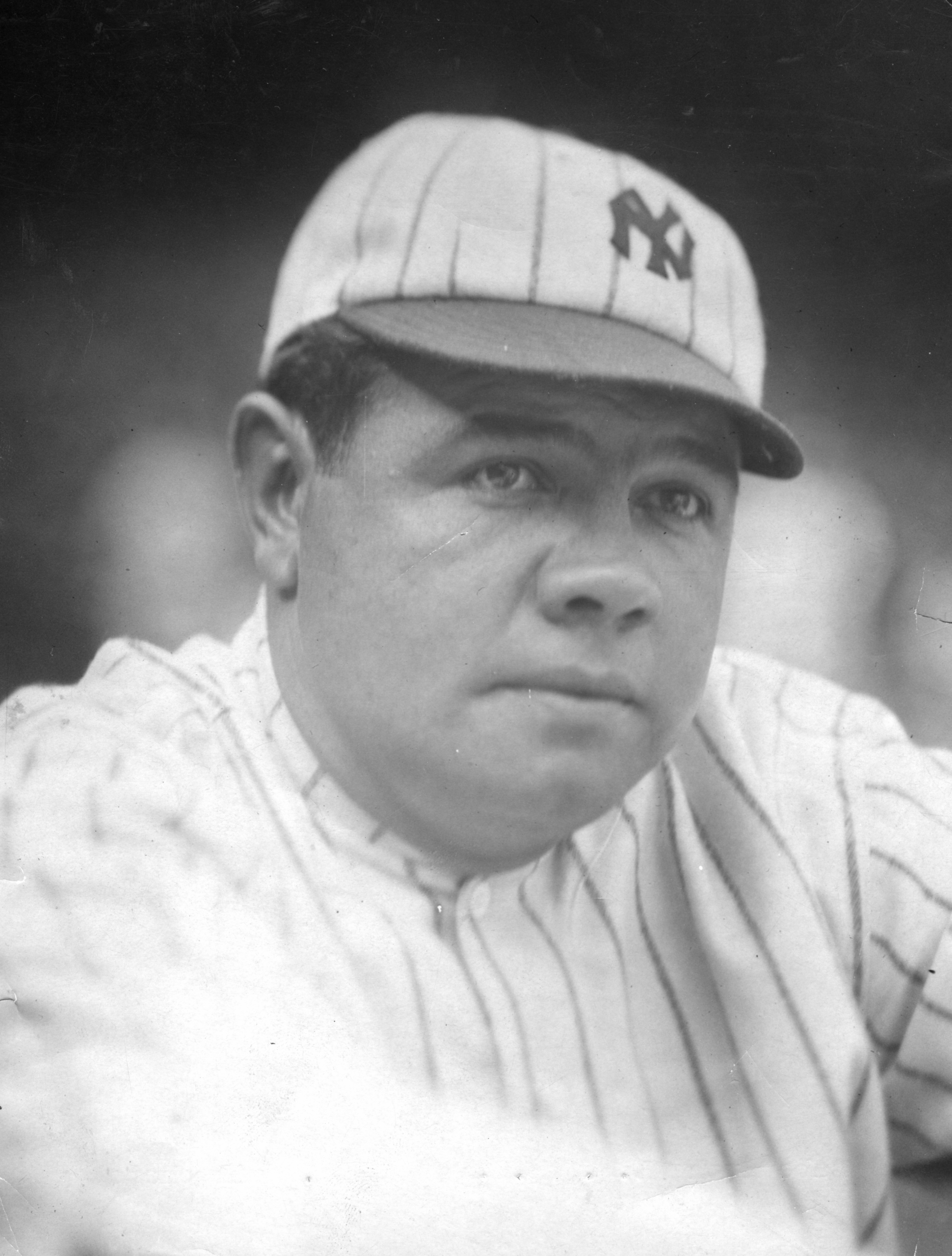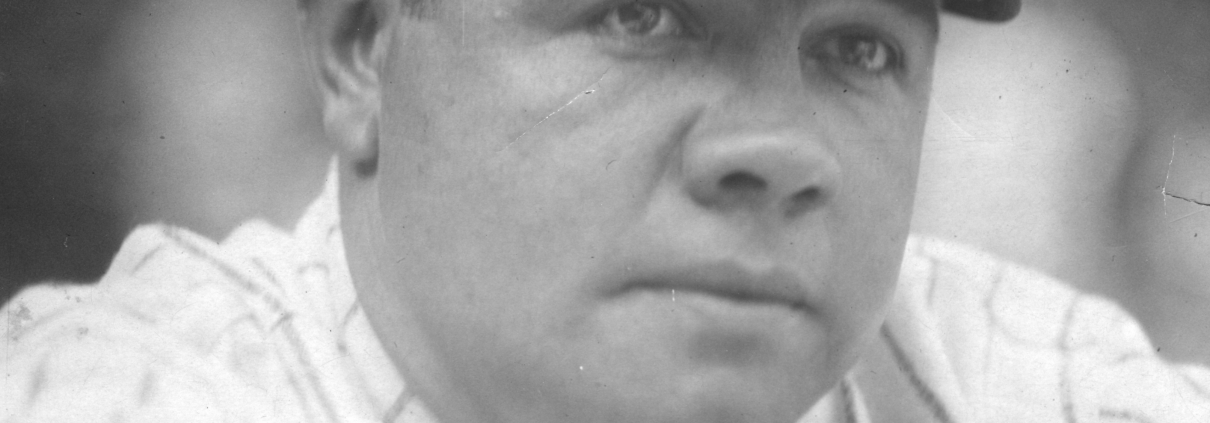October 1, 1921: Babe Ruth yields six runs as relief pitcher, then earns win in 11th
 With three games left to play in their 1921 season, the New York Yankees held a 2½-game lead over the defending World Series Champion Cleveland Indians in the American League standings. The two contenders had been tied for first place (with New York at 92-54 and Cleveland at 93-55) as late as September 24, but New York had won three of its next four (including two critical games against Cleveland), thereby seizing the league lead.
With three games left to play in their 1921 season, the New York Yankees held a 2½-game lead over the defending World Series Champion Cleveland Indians in the American League standings. The two contenders had been tied for first place (with New York at 92-54 and Cleveland at 93-55) as late as September 24, but New York had won three of its next four (including two critical games against Cleveland), thereby seizing the league lead.
The Yankees had a scheduled doubleheader for September 30 against the last-place Philadelphia Athletics,1 to be played in Philadelphia, but rain forced the games to be moved to New York and played on October 1. Cleveland played on the road against the seventh-place Chicago White Sox.
With a magic number of 1,2 New York skipper Miller Huggins was hoping to clinch the pennant in the first game of the twin bill, so he sent 26-game winner Carl Mays to the mound. Mays had won his last eight decisions, dating back to August 13. A crowd of 28,000 went through the turnstiles at the Polo Grounds to root on their Yankees. Mays was opposed by Jim Sullivan, who had been recently acquired by the Athletics from Baltimore of the International League. In contrast to the experience of Mays, Sullivan was making just the second appearance of his major-league career. The rookie right-hander had pitched a complete game against the Red Sox but had been tagged for eight runs (four earned) in his debut on September 27.
On this Saturday afternoon, Sullivan’s teammates again let him down defensively. He pitched another complete game, but New York got to him for five runs (two earned) as the Athletics committed three fielding errors. For New York, Mays helped his own cause with a 2-for-3 performance at the plate, scoring a run and adding a sacrifice bunt. In eight of the nine innings he pitched, Mays faced only three or four batters. In the top of the fourth inning, however, the Athletics banged out five hits (including a double and two triples) and scored three times. It wasn’t enough, however, and the Yankees won the opener, 5-3. They had clinched the American League pennant and now were going to their first World Series, to face the National League champs, the New York Giants, their landlords at the Polo Grounds.
But they still needed to play the second game of the doubleheader.
Waite Hoyt assumed the mound duties for New York, in search of his 20th win of the season. Philadelphia manager Connie Mack called on Eddie Rommel. Both right-handers were making their 32nd starts of the season. Through 31 starts, Rommel’s earned-run average (3.80) was more than half a run higher than Hoyt’s (3.17).
In the bottom of the first, Yankees leadoff batter Elmer Miller launched a ball to deep right center for a triple but in trying for an inside-the-park home run, he “was sent home by Coach [Chick] Fewster and was an easy out.”3 (The play was 8-4-2 for the tag out at home.) The Yankees, however, did break onto the scoreboard first, in the third inning. Hoyt singled up the middle with one out. Miller singled to left and rookie Johnny Mitchell doubled to right, driving in Hoyt and sending Miller to third. That brought Babe Ruth, described by New York’s Daily News as the “buster of records,”4 to the plate. Ruth’s groundout to first baseman Frank Brazill resulted in Miller scoring New York’s second run of the inning.
Three more New York runs came an inning later. After Fewster walked, Rommel struck out Home Run Baker and Al DeVormer. Jack Quinn entered as a pinch-hitter5 for Hoyt and singled to center, with Fewster going to third base. Miller then “slamm[ed] the sphere to the most distant suburbs in right centre field and flash[ed] all the way around the paths”6 for a three-run home run. Quinn stayed in the game as the second New York pitcher.
In the fifth frame, “a single tally was added to the Manhattan heap.”7 Ruth collected his sole hit of the game, a single to right. He advanced to second on Chicken Hawks’ one-out single and scored when Fewster deposited a Rommel offering into left field for a double. The Yankees had built a 6-0 lead.
Quinn pitched three innings, giving up a walk and single in the top of the fifth. He pitched out of the jam and retired the last eight batters he faced.
In the eighth inning, with the Yankees still holding a six-run advantage, the “fans yelled for Babe Ruth to pitch.”8 The former Red Sox pitching star had not pitched since June 13,9 but Huggins complied, so Ruth moved from first base to the mound.10
According to the New York Times, “the discourteous guests made an awful mess of the Bambino.”11 Philadelphia sent 12 batters to the plate to face Ruth in the inning. After Rommel was retired on a comebacker to the mound, the next eight batters reached. Whitey Witt walked and moved to third base on Jimmy Dykes’ single. Both baserunners scored when Tillie Walker tripled, cutting the deficit to 6-2.
Cy Perkins then hit an RBI single to left, and Frank Welch smacked an inside-the-park home run to center. The Yankees’ lead was down to one run.
Huggins left Ruth in, and Chick Galloway greeted this decision with a double. Frank Callaway drove in Galloway with a single, tying the game, before Brazill walked. Rommel made his second out of the inning with his second comebacker to Ruth (both runners advanced a base). Ruth then plunked Witt, loading the bases, before Dykes grounded out to second. The A’s had scored six runs and forged a tie.
Philadelphia created a little excitement in the top of the ninth. Ruth was still pitching. Tillie Walker singled to left to start the frame. Perkins was called out on strikes, but “he made a kick on the decision,”12 and in disputing the call, pushed the home-plate umpire, Frank Wilson. On-deck batter Welch joined the fray; Wilson ejected Perkins for arguing about strikes — Johnny Walker replaced him at catcher in the bottom of the inning. Avoiding what could have been his own ejection, Welch rapped into a 6-4-3 double play that got Ruth out of the raucous half-inning with only three batters faced.
New York didn’t score in the home half of the ninth, although Ruth drew a two-out walk and reached scoring position by swiping second base before Rommel retired Braggo Roth to end the inning. As the game moved into extra innings, Ruth went back to the mound and allowed a two-out infield single to Brazill in the 10th. Rommel retired the Yankees in order in the bottom half.
The teams “jogged along into the eleventh still wrapped up in this mutual grip.”13 The Athletics managed to get two baserunners on a walk to Dykes and a single by Tillie Walker, but both runners were stranded, as Ruth struck out Johnny Walker and induced a groundout by Welch.
With two outs in the home half, Tom Rogers — who had replaced Miller in center field in the top of the 10th inning — drove a two-bagger to left. Mitchell sealed a victory by singling to center, scoring Miller with the winning run in what has become known as “walk-off” fashion.
Ruth survived to get the relief win, but it was Miller who was the Yankees’ offensive star. He was 3-for-5 with three runs batted in and two runs scored. Mitchell and Fewster each added two hits.
Ruth had appeared in 158 games as a pitcher for the Boston Red Sox, starting 143 of them. He made one start in 1920 for the Yankees (which he won), and two appearances in 1921 (both of which he won). His next opportunity on the mound came in 1930, nine years later, in an end-of-season start against the Red Sox (which he won). He then had one more turn on October 1, 1933, exactly 12 years after this game, which he also won.14 In 10 seasons as a pitcher, Ruth never had a losing season. (Frank Welch’s inside-the-park home run was the 10th and final home run that Ruth allowed in his pitching career.)
The Yankees had won nine of their final 11 games down the stretch and ultimately took the American League crown by 4½ games over Cleveland. They lost the World Series to the Giants, five games to three. Ruth did not pitch in the World Series but batted .313 with a homer and four runs batted in.
Sources
In addition to the sources mentioned in the Notes, the author consulted Baseball-Reference.com, Retrosheet.org and SABR.org, and these box scores:
baseball-reference.com/boxes/NYA/NYA192110012.shtml
retrosheet.org/boxesetc/1921/B10012NYA1921.htm
Notes
1 The Yankees also played a single game against the Boston Red Sox on October 2, winning 7-6. In that game, Ruth smashed his record-setting 59th home run of the season. Cleveland dropped both games against the White Sox.
2 A New York win or Cleveland loss meant that the Yankees clinched the pennant.
3 Marshall A. Hunt, “Hats Off to Yanks! Grab First American League Pennant,” New York Daily News, October 2, 1921: 3.
4 Hunt.
5 This was Quinn’s only pinch-hit appearance of the season, and it was just the third time in his American League career. In 1915, while playing for the Baltimore Terrapins in the Federal League, Quinn had 11 pinch-hit at-bats. For his career, which spanned 23 seasons, Quinn had four hits in 15 pinch-hit opportunities (a .267 average).
6 “Yankees Are 1921 League Champions,” New York Times, October 2, 1941: 124.
7 “Yankees Are 1921 League Champions.”
8 “Yanks Make Sure by Grabbing Twin Bill,” Philadelphia Inquirer, October 2, 1921: 23.
9 Ruth made his only other pitching appearance of 1921 on June 13 against the Detroit Tigers. He started and pitched five innings, allowing four runs. The Yankees gave him great run support and won the contest, 13-8.
10 In the top of the fourth inning, Ruth had moved from left field to play first base, with Hawks replacing him in left. Backup catcher Fred Hofmann came out of the dugout to play first base in the eighth inning.
11 “Yankees Are 1921 League Champions.”
12 Hunt.
13 “Yankees Are 1921 League Champions.”
14 For details of Ruth’s final two pitching outings, see: Bill Nowlin and Glen Sparks, eds., The Babe (Phoenix: SABR, 2019).
Additional Stats
New York Yankees 7
Philadelphia Athletics 6
11 innings
Game 2, DH
Polo Grounds
New York, NY
Box Score + PBP:
Corrections? Additions?
If you can help us improve this game story, contact us.


